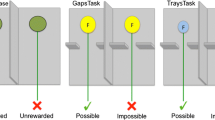Abstract
A horizontal plexiglas tube containing a food-reward was presented to four naive tufted capuchins and suitable sticks were provided to push the reward out. Three monkeys out of four spontaneously used the tools and showed very different styles of solving the task. In more complex conditions, in which the sticks needed to be combined or actively modified in order to become effective, the monkeys were always successful; however, their performance was loaded with errors which did not disappear throughout the trials. Evidence of a difference between success in solving the problem and its understanding was found. This suggests that although capuchins can discover new means through active experimentation, they do not mentally represent the characteristics necessary for a tool to be effective, nor do they modify the tool appropriately beforehand. At this level, a major difference with chimpanzees emerges.
Similar content being viewed by others
References
Altmann, J., 1974. Observation study of behavior: Sampling methods.Behaviour, 49: 337–367.
Antinucci, F. &E. Visalberghi, 1986. Tool use inCebus apella: A case study.Int. J. Primatol., 7: 349–361.
Bates, E., 1979.The Emergence of Symbols. Academic Press, New York.
Beck, B. B., 1980.Animal Tool Behavior. Garland Press, New York.
Boesch, C. & E. Boesch, 1988. Tool use and tool making in wild chimpanzees. Colloque International de la Fondation Fyssen,L'usage de l'outil chez les primates humains et non-humains, Versailles, November 25–29.
———— &H. Boesch, 1983. Optimisation of nut-cracking with natural hammers by wild chimpanzees.Behaviour, 83: 265–286.
Boinski, S., 1988. Use of a club by a wild white-faced capuchin (Cebus capucinus) to attack a venomous snake (Bothrops asper).Amer. J. Primatol., 14(2): 177–179.
Cooper, L. R. &H. F. Harlow, 1961. Note on a cebus monkey's use of a stick as a weapon.Psychol. Rep., 8: 418.
Costello, M. B., 1987. Tool use and manufacture in manipulanda-deprived capuchins (Cebus apella).Amer. J. Primatol., 12(3): 337. (Abstract)
Fedigan, L. M., in press. Vertebrate predation inCebus capucinus: meat eating in a neotropical monkey.Folia Primatol.
Fragaszy, D. M. &E. Visalberghi, 1989. Social influences on the acquisition and use of tools in tufted capuchin monkeys (Cebus apella).J. Comp. Psychol., 103: 159–170.
Glickman, S. E. &S. W. Sroges, 1966. Curiosity in zoo animals.Behaviour, 26: 151–188.
Goodall, J., 1986.The Chimpanzees of Gombe. The Belknap Press of Harvard Univ. Press.
Hoffstetter, R., 1974. Phylogeny and geographic deployment of the Primates.J. Human Evol., 3: 327–350.
————, 1980. Origin and deployment of New World monkeys emphasizing the southern continents route. In:Evolutionary Biology of the New World Monkeys and Continental Drift,R. L. Ciochon &B. Chiarelli (eds.), Plenum Press, New York & London, pp. 103–122.
Kluver, H., 1933.Behavior Mechanisms in Monkeys. Univ. of Chicago Press, Chicago.
————, 1937. Re-examination of implement-using behaviour in a cebus monkey after an interval of three years.Acta Psychol., 2: 347–397.
Koehler, W., 1925.The Mentality of Apes. Routledge & Kegan Paul, London.
McGrew, W. C., 1974. Tool use by wild chimpanzees in feeding upon driver ants.J. Human Evol., 3: 501–508.
----, in press. Why is ape tool-use so confusing? In:Comparative Socioecology: the Behavioral Ecology of Humans and Other Mammals,V. Standen & R. Foley (eds.), Blackwell, Oxford.
Parker, S. &K. R. Gibson, 1977. Object manipulation, tool use and sensorimotor intelligence as feeding adaptations in cebus monkeys and great apes.J. Human Evol., 6: 623–641.
Poti', P. & S. T. Parker, in press. The role of innate fixed action patterns in ontogenetic and experiential development of intelligent use of sticks inCebus monkeys. In:Language and Intelligence in Monkeys and Apes: Comparative Developmental Perspectives,S. T. Parker & K. Gibson (eds.), Cambridge Univ. Press, Cambridge.
Terborgh, J. W., 1983.Five New World Primates: A Study in Comparative Ecology. Princeton Univ. Press, Princeton.
Visalberghi, E., 1987. The acquisition of nut-cracking behavior in two capuchin monkeys groups (Cebus apella).Folia Primatol., 49: 168–181.
————, 1988. Responsiveness to objects in two social groups of tufted capuchin monkeys (Cebus apella).Amer. J. Primatol., 15: 349–360.
———— &W. A. Mason, 1983. Determinants of problem-solving success inSaimiri andCallicebus.Primates, 24: 385–396.
Westergaard, G. C. &D. M. Fragaszy, 1985. Effects of manipulatable objects on the activity of capuchin monkeys (Cebus apella).Zoo Biol., 4: 317–327.
———— & ————, 1987. The manufacture and use of tools by capuchin monkeys (Cebus apella).J. Comp. Psychol., 2: 159–168.
Yerkes, R. M., 1943.Chimpanzees. Yale Univ. Press, New Haven.
———— &A. W. Yerkes, 1929.The Great Apes. Yale Univ. Press, New Haven.
Author information
Authors and Affiliations
About this article
Cite this article
Visalberghi, E., Trinca, L. Tool use in capuchin monkeys: Distinguishing between performing and understanding. Primates 30, 511–521 (1989). https://doi.org/10.1007/BF02380877
Received:
Accepted:
Issue Date:
DOI: https://doi.org/10.1007/BF02380877




